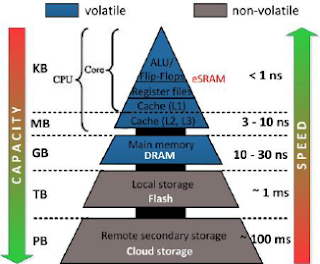Memory Hierarchy
Memory hierarchy is a pyramid structure that is commly used to illustrate the significant difference among memory type.
The memory unit is an essential component for the storage of program and data on any digital computer. A computer's total memory capacity can be viewed as a "component hierarchy."
Memory hierarchy usually consists of a triangle with hard drives (physical long-term storage disks) at the bottom and quicker, smaller data storage methods near the top (Cache, RAM). Memory storage methods close to the top of the triangle are faster, but have less capacity, while methods close to the bottom are slower, but have much more capacity. In programming, the computer programmer wants to optimize its code so that the higher memory storage methods handle fast and fast processes, and the less needed information is stored lower on the triangle.
Memory hierarchy
Component of Memory hierarchy
Auxiliary Memory:
It is used for backup storage and store large amount of data.It is not directly connected with c.p.u.
Main memory:
It is a area in a computer in which data is store for quick access by computer processor.
Cache Memory:
It is used by central process unit (c.p.u) to reduce the average time or energy to access data from memory.
Resistor:
It is internal processor memory.It access the data for less then >l ns.
Memory hierarchy
Work of Memory hierarchy
- Decreasing cost per bit.
- Increasing capacity.
- Increasing access time.
- Decreasing frequency of access. .


Comments
Post a Comment